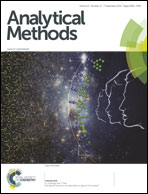Multifactorial design principles applied for the simultaneous separation of local anesthetics using chromatography modeling software
Abstract
This study describes the development of liquid chromatographic methods for the simultaneous separation of some of the most popular local anesthetics in pharmaceutical preparations and medical praxis (benzocaine, bupivacaine, chloroprocaine lidocaine, oxybuprocaine, prilocaine, procaine, propipocaine and tetracaine) based on a systematic approach using experimental design methodology in which one or more factors are changed at the same time. The strategy employs a chromatography modeling software for the simultaneous optimization of critical chromatographic parameters, which are gradient time tG, temperature T and the ternary composition of the organic eluent B. Three different stationary phases were investigated, which are: Kromasil C18, Prontosil C18-AQ and Luna Phenyl-Hexyl. To build the design space for each column, 12 initial experiments were carried out by systematical variation of the selected critical parameters simultaneously. The chromatographic conditions of these initial runs are based on two different gradient times (tG = 20 and 60 min, linear gradient system from 10–90% organic modifier B) each at two different temperatures (T = 25 and 40 °C) repeated at three different ternary composition of the eluent B (a) 100% acetonitrile, (b) acetonitrile–methanol (50 : 50) (v/v), and (c) 100% methanol. In all experiments the pH value of the eluent A (20 mM phosphate buffer) was kept at 3.0. The mixture of local anesthetics could be well separated on all three stationary phases. Although not demonstrated in this paper, this method should be suitable for the analysis of LAs in pharmaceutical preparations or to detect them in some illegal cosmetics. The results showed that the selectivity and the elution order were similar on Kromasil C18 and Prontosil C18-AQ. On the other hand, a unique selectivity is resulted on Luna Phenyl-Hexyl, which shows, depending on the analytes, some additional interactions, since the separation mechanism on this column is influenced by its different steric and polar properties compared to the separation mechanism of alkyl-bonded phases. The predictions and real experiments were strongly correlated with an average absolute error (ΔtR) of 0.13 min (<8 s).


 Please wait while we load your content...
Please wait while we load your content...